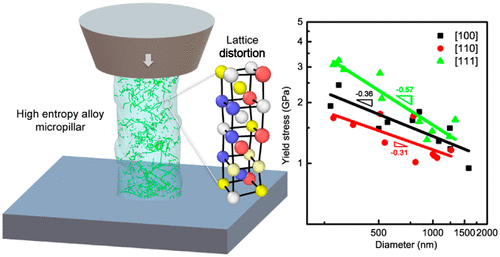当前位置:
X-MOL 学术
›
Nano Lett.
›
论文详情
Our official English website, www.x-mol.net, welcomes your
feedback! (Note: you will need to create a separate account there.)
Deformation Mechanisms and Remarkable Strain Hardening in Single-Crystalline High-Entropy-Alloy Micropillars/Nanopillars
Nano Letters ( IF 9.6 ) Pub Date : 2021-03-23 , DOI: 10.1021/acs.nanolett.1c00444 Qian Zhang 1 , Ruirui Huang 1 , Xuan Zhang 1 , Tangqing Cao 2 , Yunfei Xue 2 , Xiaoyan Li 1
Nano Letters ( IF 9.6 ) Pub Date : 2021-03-23 , DOI: 10.1021/acs.nanolett.1c00444 Qian Zhang 1 , Ruirui Huang 1 , Xuan Zhang 1 , Tangqing Cao 2 , Yunfei Xue 2 , Xiaoyan Li 1
Affiliation

|
There have been very limited studies on plastic deformation mechanisms in single-crystalline high-entropy alloys (HEAs) with body-centered cubic (BCC) phases. We performed in situ uniaxial compression on single-crystalline BCC AlCrFeCoNi micropillars/nanopillars with three orientations (including [100], [110], and [111]) and diameters of 270–1583 nm, inside a scanning electron microscope. The experimental results showed the significant size effects on yield/flow stress and the remarkable strain hardening in these HEA micropillars/nanopillars. Especially, HEA micropillars/nanopillars with ⟨100⟩ orientation exhibited higher strain hardening exponents than BCC pure metals and Al0.7CrCoFeNi counterparts. A combination of transmission electron microscopy observations and large-scale atomistic simulations revealed that dislocation slip, reaction, tangling and accumulation, and solid solution effects are responsible for the observed size effects on yield/flow stress and remarkable strain hardening, but these dislocation mechanisms are dependent on nanopillar orientation. Our present study sheds light on the underlying deformation mechanisms in BCC HEA single crystals.
中文翻译:

单晶高熵合金微柱/纳米柱的变形机制和明显的应变硬化
关于具有体心立方(BCC)相的单晶高熵合金(HEA)的塑性变形机制的研究非常有限。我们在扫描电子显微镜内对具有三个方向(包括[100],[110]和[111])且直径为270-1583 nm的BCC AlCrFeCoNi单晶微柱/纳米柱进行了原位单轴压缩。实验结果表明,在这些HEA微型柱/纳米柱中,尺寸对屈服/流动应力具有显着的影响,并且应变硬化显着。特别是,取向为⟩100⟩的HEA微型柱/纳米柱比BCC纯金属和Al 0.7具有更高的应变硬化指数。CrCoFeNi对应物。透射电子显微镜观察和大规模原子模拟的结合表明,位错滑移,反应,缠结和聚集以及固溶效应是所观察到的尺寸对屈服/流动应力和显着应变硬化的影响,但是这些位错机理是取决于纳米柱的方向。我们目前的研究揭示了BCC HEA单晶的潜在变形机制。
更新日期:2021-04-29
中文翻译:

单晶高熵合金微柱/纳米柱的变形机制和明显的应变硬化
关于具有体心立方(BCC)相的单晶高熵合金(HEA)的塑性变形机制的研究非常有限。我们在扫描电子显微镜内对具有三个方向(包括[100],[110]和[111])且直径为270-1583 nm的BCC AlCrFeCoNi单晶微柱/纳米柱进行了原位单轴压缩。实验结果表明,在这些HEA微型柱/纳米柱中,尺寸对屈服/流动应力具有显着的影响,并且应变硬化显着。特别是,取向为⟩100⟩的HEA微型柱/纳米柱比BCC纯金属和Al 0.7具有更高的应变硬化指数。CrCoFeNi对应物。透射电子显微镜观察和大规模原子模拟的结合表明,位错滑移,反应,缠结和聚集以及固溶效应是所观察到的尺寸对屈服/流动应力和显着应变硬化的影响,但是这些位错机理是取决于纳米柱的方向。我们目前的研究揭示了BCC HEA单晶的潜在变形机制。





















































 京公网安备 11010802027423号
京公网安备 11010802027423号